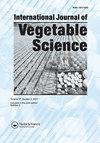利用巴巴苏棕榈轴生物炭生产生菜
IF 1.1
Q2 Agricultural and Biological Sciences
引用次数: 1
摘要
摘要利用生物质残留物生产的生物炭可以改善土壤的物理、化学和生物条件,减少温室气体排放,提高作物产量。本研究通过在盆栽培养中添加0、10、20或30 t∙ha−1的巴巴苏棕榈(Attalea speciosa Mart.)轴上的生物炭,评估了营养不良的黄色Latosol(LAd)中莴苣(Lactuca sativa L.,cv.Babáde Verão)的产量,并评估了莴苣的生长和产量。用30 t∙ha−1的生物炭种植的生菜提高了株高、叶片数量和总新鲜质量。促进地上部新鲜质量、地上部干质量、鲜根质量、根干质量和总干质量积累的速率在17.3和27 t∙ha-1之间。生物炭的使用可能是一种替代方法,可以改善盆栽生菜连续作物中LAd土壤的物理和化学条件。随着生物炭用量的增加,LAd土壤的校正提高了盆栽生菜的生长和产量。本文章由计算机程序翻译,如有差异,请以英文原文为准。
Lettuce production with rates of biochar from babassu palm rachis
ABSTRACT Use of biochar produced from biomass residues may improve physical, chemical, and biological conditions of soil, reduce greenhouse gas emissions, and increase crop yields. This study evaluated production of lettuce (Lactuca sativa L., cv. Babá de Verão) in a dystrophic Yellow Latosol (LAd) by adding biochar from the babassu palm (Attalea speciosa Mart.) rachis at 0, 10, 20, or 30 t∙ha−1 in pot culture, and growth and production of lettuce evaluated. Lettuce grown with 30 t∙ha−1 of biochar improved plant height, number of leaves, and total fresh mass. Rates that promoted greater accumulation of fresh mass of the aerial part, aerial part dry mass, fresh root mass, root dry mass, and total dry mass ranged between 17.3 and 27 t∙ha−1 of biochar. Use of biochar may be an alternative to improve physical and chemical conditions of LAd soil in successive crops of lettuce in pot culture. The correction of the LAd soil with increasing rates of biochar increased growth and yield of lettuce in pot culture.
求助全文
通过发布文献求助,成功后即可免费获取论文全文。
去求助
来源期刊

International Journal of Vegetable Science
Agricultural and Biological Sciences-Plant Science
CiteScore
3.10
自引率
0.00%
发文量
30
期刊介绍:
The International Journal of Vegetable Science features innovative articles on all aspects of vegetable production, including growth regulation, pest management, sustainable production, harvesting, handling, storage, shipping, and final consumption. Researchers, practitioners, and academics present current findings on new crops and protected culture as well as traditional crops, examine marketing trends in the commercial vegetable industry, and address vital issues of concern to breeders, production managers, and processors working in all continents where vegetables are grown.
 求助内容:
求助内容: 应助结果提醒方式:
应助结果提醒方式:


